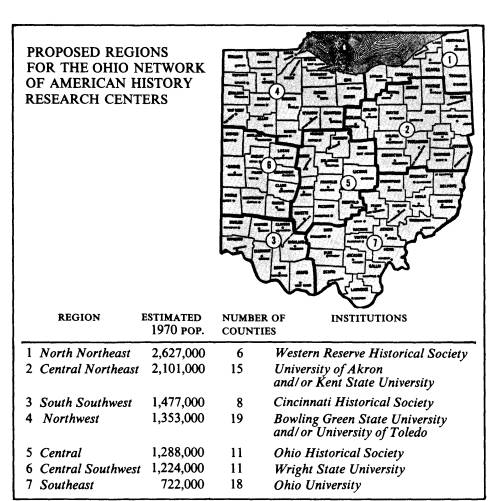Ohio History Journal
Essay and Comment
OHIO NETWORK OF AMERICAN HISTORY
RESEARCH CENTERS: A PROPOSAL
A general characteristic of Americans
has always been the overemphasis on quan-
tity and competition to the point of
blurring a full consideration of the advantages
of quality and cooperation. The rapid
changes of the twentieth century resulting
in the formation of a complex of
ever-increasing interwoven relationships between
people and their institutions
necessitates the redirection of traditional patterns of
behavior. The effect of the prevailing
competitive mood on the historical profes-
sion, especially in Ohio, in the field
of library and archives has been to encourage
major research centers--usually graduate
universities, state and municipal histori-
cal societies, and private libraries--to
operate as introspective units justifying their
existence solely on their own
accomplishments rather than in terms of their role
in the overall historical collection
process. This egocentric attitude must be aban-
doned or collections in the research
institutions will become so proliferated by the
last quarter of this century that both
quality of service and the possibility of coop-
eration between centers will be in
jeopardy.
Ohio has the greatest need of the
nation's large, industrial urban states to break
through the shibboleths of the past and
devise an uniform statewide formula that
will insure the preservation of
historically important materials within the state. The
key element making Ohio different from
other states is the decentralization of its
population and educational centers.
Rather than having the population polarized
in one or two areas, Ohio has six major
metropolitan regions.1 The political and
economic power bases in the state are
also in these areas. Higher education in
Ohio reflects this division as the state
has developed a series of twelve regional
state-supported schools, and all but
Central State University are now offering grad-
uate degrees. Higher education is
centered in the six major urban areas: nine of
the twelve schools are in the six
metropolitan areas, and the four private graduate
universities--Case Western Reserve
University, John Carroll University, Xavier
University, and University of Dayton--are
located in large cities.
The growth of graduate programs has been
developed on the local levels with-
out benefit of a statewide plan.
Proliferation of advanced degree-granting institu-
tions is seen in the dramatic surge of
history graduate programs from two Ph.D.
programs in 1960 to seven in 1970 and
another two ready to begin in a year or
two, and in a similar rise in M.A.
programs from eight in 1960 to sixteen today.2
Once again Ohio appears to have achieved
a noble record of quantity without
building at least one graduate history
program up to the quality level of such tra-
ditionally strong midwestern schools at
the universities of Wisconsin, Michigan,
and Chicago.3 This emphasis
on expansion of centers of higher education in Ohio
will have far-reaching consequences for
history research centers. The presence of
1. Cleveland, Cincinnati, Columbus,
Dayton, Toledo, and Akron in order of population.
2. The Ph.D. degree granting
universities are: Akron, Case Western Reserve, Cincinnati, Kent
State, Miami, Ohio State, and Toledo.
Two schools, Ohio University and Bowling Green State Uni-
versity have Regent approved programs
about ready to begin. In addition to these nine schools, all of
which grant master's degrees, are six
others that grant only the master's and not the Ph.D. degree:
Cleveland State, Dayton, John Carroll,
Wright State, Xavier, and Youngstown State.
3. In the most recent rating of graduate
schools by department, not one Ohio history department
placed in the top twenty schools, yet
Ohio is fifth in the nation in population and fourth in wealth.
See American Council on Education, An Assessment of
Quality in Graduate Education (Washington,
D.C., 1966), 38-39.
